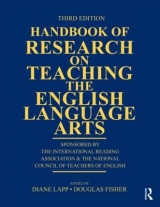
Handbook of Research on Teaching the English Language Arts
Lawrence Erlbaum Associates Inc (Verlag)
978-0-8058-4518-1 (ISBN)
- Titel erscheint in neuer Auflage
- Artikel merken
Contents: J. Flood, D. Lapp, J.R. Squire, J.M. Jensen, Preface. Part I:Historical and Theoretical Perspectives for English Language Arts Teaching and Learning. J.R. Squire, The History of the Profession. J. Dixon, Historical Considerations: An International Perspective. P. Menyuk, Linguistics and Teaching the Language Arts. D.L. Schallert, D.B. Martin, A Psychological Analysis of What Teachers and Students Do in the Language Arts Classroom. M.M. Clay, Child Development. D. Bloome, Anthropology and Research on Teaching the English Language Arts. L.M. Rosenblatt, Literary Theory. L. Baines, E.J. Farrell, The Tao of Instructional Models. L.P. Ruth, Who Has the Power? Policymaking and Politics in the English Language Arts. K. Smith, P.L. Stock, Trends and Issues in Research in the Teaching of the English Language Arts. Part II:Methods of Research on English Language Arts Teaching. S. Stotsky, C. Mall, Understanding Research on Teaching the English Language Arts: An Introduction for Teachers. A. DiPardo, Teacher Professionalism and the Rise of "Multiple Literacies": How to Describe Our Specialized Knowledge? R.C. Calfee, M. Chambliss, The Design of Empirical Research. R.J. Tierney, M. Sheehy, What Longitudinal Studies Say About Literacy Development/What Literacy Development Says About Longitudinal Studies. J. Birnbaum, J. Emig, D. Fisher, Case Studies: Placing Literacy Phenomena Within Their Actual Context. J.L. Green, C.N. Dixon, A. Zaharlick, Ethnography as a Logic of Inquiry. F.R. Burton, B.L. Seidl, Teacher Researcher Projects: From the Elementary School Teacher's Perspective. B. Fecho, J. Allen, Teacher Inquiry Into Literacy, Social Justice, and Power. C.B. Smith, S.S. Klein, Synthesis Research in Language Arts Instruction. D.E. Alvermann, G.G. Hruby, Fictive Representation: An Alternative Method for Reporting Research. M.C. Wittrock, Contemporary Methodological Issues and Future Directions in Research on the Teaching of English. Part III:Research on Language Learners. R.S. Brause, J.S. Mayher, Who Really Goes to School? Teaching and Learning for the Students We Really Have. E. Sulzby, W.H. Teale, The Development of the Young Child and the Emergence of Literacy. K.L. Dahl, P.L. Scharer, L.L. Lawson, P.R. Grogan, Student Achievement and Classroom Case Studies of Phonics in Whole Language First Grades. D.S. Strickland, J.T. Feeley, Development in the Elementary School Years. J. Simmons, P.S. Carroll, Today's Middle Grades: Different Structures, Students, and Classrooms. T. Newkirk, The Learner Develops: The High School Years. R.L. Venezky, Literacy Learning After High School. J.S. Chall, M.E. Curtis, Children With Reading Difficulties. S. Hudelson, L. Poyner, P. Wolfe, Teaching Bilingual and ESL Children and Adolescents. A.F. Ball, M. Farr, Language Varieties, Culture and Teaching the English Language Arts. C.H. Brock, F.B. Boyd, J.A. Moore, Variation in Language and the Use of Language Across Contexts: Implications for Literacy Learning. M. Myers, Issues in Teacher Preparation and Staff Development in English Language Arts. S. Fitzgerald, Teacher Evaluation. J.C. Hartse, R.F. Carey, Pursuing Diversity. Part IV:Environments for English Language Arts Teaching. G.E. Tompkins, E. Tway, The Elementary School Classroom. A.A. Glatthorn, D.L. Shouse, Secondary English Classroom Environments. D.B. Yaden, Jr., J.R. Paratore, Family Literacy at the Turn of the Millennium: The Costly Future of Maintaining the Status Quo. C.K. Kinzer, K. Leander, Technology and the Language Arts: Implications of an Expanded Definition of Literacy. J.R. Paratore, R. Indrisano, Grouping for Instruction in Literacy. C.W. Peters, K.K. Wixson, Unifying the Domain of K-12 English Language Arts Curriculum. R. Farr, M.D. Beck, Evaluating Language Development. Y.M. Goodman, Informal Methods of Evaluation. N. Frey, E.H. Hiebert, Teacher-Based Assessment of Literacy Learning. J.V. Hoffman, S.G. Paris, E. Patterson, R. Salas, L. Assaf, High-Stakes Assessment in the Language Arts: The Piper Plays, the Players Dance, but Who Pays the Price? J.A. Dole, J. Osborn, Elementary Language Arts Textbooks: A Decade of Change. L. Galda, B.E. Cullinan, Literature for Literacy: What Research Says About the Benefits of Using Trade Books in the Classroom. B. Bruce, J. Levin, Roles for New Technologies in Language Arts: Inquiry, Communication, Construction, and Expression. C. Cox, The Media Arts. A.E. Cunningham, K.E. Stanovich, Reading Matters: How Reading Engagement Influences Cognition. A.N. Applebee, Balancing the Curriculum in the English Language Arts: Exploring the Components of Effective Teaching and Learning. Part V:Research on Teaching Specific Aspects of the English Language Arts Curriculum. R.J. Marzano, Language, the Language Arts, and Thinking. J.W. Ney, Teaching the Roots of Modern English: The History of the Language in the Language Arts Class. G. Hillocks, Jr., M.W. Smith, Grammars and Literacy Learning. S. Templeton, Spelling. J.F. Baumann, E.J. Kame'enui, G.E. Ash, Research on Vocabulary Instruction: Voltaire Redux. N. Nelson, J.L. Kinneavey, Rhetoric. M. Martinez, N.L. Roser, Children's Responses to Literature. R.E. Probst, Response to Literature. V.J. Harris, A.I. Willis, Multiculturism, Literature, and Curriculum Issues. S.L. Sebesta, D.L. Monson, Reading Preferences. A.C. Purves, G.M. Pradl, The School Subject Literature. L.M. Morrow, Motivating Lifelong Voluntary Readers. B. Edmiston, P.E. Enciso, Reflections and Refractions of Meaning: Dialogic Approaches to Classroom Drama and Reading. G.S. Pinnell, A.M. Jaggar, Oral Language: Speaking and Listening in Elementary Classrooms. J.M. Mason, S.A. Stahl, K.H. Au, P.A. Herman, Reading: Children's Developing Knowledge of Words. J. Flood, D. Lapp, D. Fisher, Reading Comprehension Instruction. T.G. Devine, J.S. Kania, Studying: Skills, Strategies, and Systems. K.H. Au, Balanced Literacy Instruction: Implications for Students of Diverse Backgrounds. A.H. Dyson, S.W. Freedman, Writing. N. Farnan, K. Dahl, Children's Writing: Research and Practice. B.J. Wagner, Imaginative Expression. J. Hansen, The Language Arts Interact. D.M. Ogle, S.I. McMahon, Curriculum Integration to Promote Literate Thinking: Dilemmas and Possibilities. R.E. Hodges, The Conventions of Writing.
| Erscheint lt. Verlag | 12.9.2002 |
|---|---|
| Verlagsort | Mahwah |
| Sprache | englisch |
| Maße | 216 x 279 mm |
| Gewicht | 2585 g |
| Themenwelt | Sozialwissenschaften ► Pädagogik |
| ISBN-10 | 0-8058-4518-6 / 0805845186 |
| ISBN-13 | 978-0-8058-4518-1 / 9780805845181 |
| Zustand | Neuware |
| Haben Sie eine Frage zum Produkt? |
aus dem Bereich



